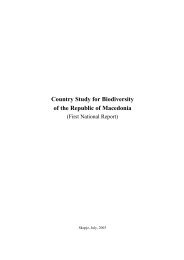CBD Fourth National Report - Azerbaijan (English version)
CBD Fourth National Report - Azerbaijan (English version)
CBD Fourth National Report - Azerbaijan (English version)
Create successful ePaper yourself
Turn your PDF publications into a flip-book with our unique Google optimized e-Paper software.
3.1.4. Indirect uses of biodiversity<br />
Country Study on Biodiversity and <strong>Fourth</strong> <strong>National</strong> <strong>Report</strong><br />
The Republic of <strong>Azerbaijan</strong><br />
<strong>Azerbaijan</strong> provides suitable conditions for the development of ecotourism, particularly for<br />
holidays based on bird-watching. Interesting bird populations can be observed at all times of<br />
year (for wintering, migration and breeding), and large colonies of herons, cormorants, gulls<br />
and tern can be seen in reed beds and islands. In winter extensive flocks of little bustards,<br />
eagles, and griffon vultures are seen in the lowlands, and large populations of water birds<br />
gather are concentrated along the Caspian coast and in inland water systems.<br />
Creation of initial <strong>National</strong> Parks in the country since 2003 has played a legal framework role<br />
for development and rational organization of in-place ecotourism and aesthetic pleasure of<br />
tourists in its boons without damage to the environment and allowed to growth of ecotourism<br />
activity.<br />
3.1.5. Cultural or traditional values of biodiversity<br />
3.1.5.1. Wildlife and national cuisine<br />
In <strong>Azerbaijan</strong>, the national cuisine reflects the traditional methods of food preparation, but<br />
incorporates the availability of foods and requirements of a modern diet. A range of<br />
agrobiodiversity and wild species are traditionally used within the national diet. Most dishes<br />
are prepared from veal, mutton and poultry. The region is also rich in fish - the main species<br />
consumed are sturgeon caught in the lake, rivers, and the sea. Meals are often prepared with a<br />
variety of ingredients to add taste. Ingredients include lemon, olives, vinegar, pomegranate<br />
syrup, plums, grapes, cherries, apricots, fruit paste, and sumakh spice.<br />
Meals are accompanied by rice, bread, and a variety of vegetables, predominantly aubergine,<br />
tomato, sweet peppers, cabbage, spinach, sorrel, beetroot, turnip, and onion. Herbs such as<br />
saffron, caraway, anise, laurel leaf, coriander, mint, dill, parsley, celery, tarragon, basil and<br />
thyme are also commonly served with, and accompany meals. These ingredients are also<br />
combined into salads. Other popular foods include caviar, omelette with vegetables or<br />
walnuts, fried beans and walnut, and other snacks. Mixes of garlic, aubergine, and hot<br />
pepper, are preserved with salt or vinegar and are served with meat courses.<br />
Meals usually start with strong black tea, to aid digestion, and for social reasons. Tea is often<br />
served with fruit preserves made from quince, watermelon, cherry, peach, plum, walnut and<br />
mulberry. The tea is sometimes flavoured with herbs and spices, such as thyme, cloves and<br />
cardamom to add flavour. In addition, the natural waters of <strong>Azerbaijan</strong> are rich in minerals<br />
and are believed to promote good health.<br />
3.1.5.2. Arts, folklore, and music<br />
Picture<br />
Located between the Middle East, Europe and Asia,<br />
on the ancient ‘Silk Route’, <strong>Azerbaijan</strong> has<br />
historically played an important part in the world<br />
economy and exchange of culture. This history is<br />
reflected in the creative culture existing today through<br />
highly skilled musicians, astrologists, sculptures and<br />
craftsmen. <strong>Azerbaijan</strong> has a great artistic history, with<br />
craft methods passed down through families. Many<br />
types of folklore are depicted through art, music,<br />
79<br />
2009

















